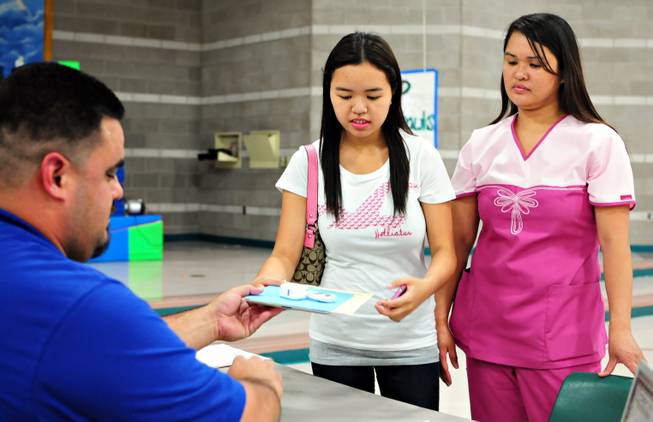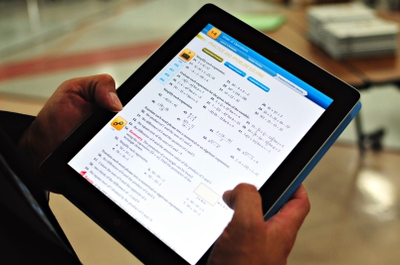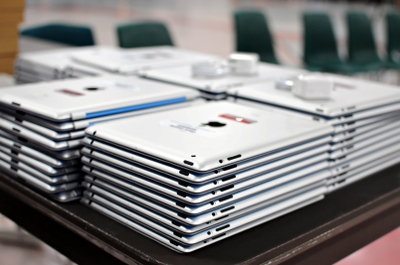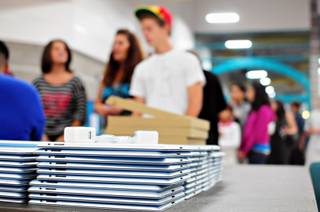
Silverado High School freshman Angelica Panes, 15, receives a new iPad 2 as her 34-year-old mother Mary Grace Gonzales watches on Tuesday, Sept. 13, 2011. The Clark County School District launched a pilot program using an iPad application to teach algebra to students at four schools during the 2011-12 school year. There will be 1,150 students using the algebra application on the iPad, developed by Houghton Mifflin Harcourt. The iPads with software cost the School District $790,050.
Wednesday, Sept. 14, 2011 | 3:23 a.m.
CCSD iPad Pilot Program
The Clark County School District launched a pilot program using an iPad application to teach algebra to students at four schools during the 2011-12 school year. There will be 1,150 students using the algebra application on the iPad, developed by Houghton Mifflin Harcourt. The iPads with software cost the School District $790,050.
Sun coverage
Paper textbooks might soon go the way of the slide rule and typewriter as the Clark County School District launches a $790,050 iPad program, the largest of its kind in the nation.
Instead of receiving hefty books, about 1,150 Las Vegas middle and high school students were given thin, iPad 2 tablets, each loaded with an interactive textbook application for their Algebra 1 classes.
Four schools are part of the one-year pilot program rolling out this week: Silverado High School, Silvestri and Leavitt Middle Schools and the Academy for Individualized Study — a school for non-traditional students, such as Cirque du Soleil performers.
The trial program is costing the School District $687 per iPad, which includes the Fuse Algebra 1 textbook application developed by publisher Houghton Mifflin Harcourt.
The application is more than just a digital textbook. It is interactive, engaging students with touch-tap lessons and video tutorials, and has note-taking capabilities, said Josef Blumenfeld, senior vice president of corporate affairs for Houghton Mifflin Harcourt.
“These are no e-books, or repurposed digital versions of textbooks,” he said. “These are reimagined, interactive books — the real benefit being we can now deliver truly personalized instruction. We’ve tried to craft something that 20 years from now will be the norm.”
The $49 Fuse application allows users to learn at their own pace, Blumenfeld said. If students miss a class, they can tap into about 400 video tutorials led by textbook author Edward Burger, a math professor at Williams College in Massachusetts.
“Videos allow for anywhere, anytime instruction,” Blumenfeld said. “For students who might have missed class or didn’t understand the lesson, you can push a button and have it explained again and again. You have a teacher available anytime, anywhere.”
•••
In a society driven more than ever by digital technology, the iPad program is another way schools are trying to keep up with the times, said Jhone Ebert, the school district’s chief technology officer.

Silverado High School freshman Catherine Rodriguez, 14, receives a new iPad 2 as her 43-year-old mother Mary Young watches on Tuesday, Sept. 13, 2011. The Clark County School District launched a pilot program using an iPad application to teach algebra to students at four schools during the 2011-12 school year. There will be 1,150 students using the algebra application on the iPad, developed by Houghton Mifflin Harcourt. The iPads with software cost the School District $790,050.
“We’re focused on students and making sure they have 21st century technology,” she said. “We shouldn’t be asking them to power down when they come into the school building.”
It’s a bold move by the cash-strapped district, which came under fire last year after purchasing $1 million worth of iPads for administrators. The school district faces a $56 million budget shortfall, which it plans to plug with concessions from its four employee unions.
District officials say it’s too early to tell if the pilot program will be cost-efficient or deliver higher test scores.
Technology is just one of many factors that affect test results. A New York Times article published earlier this month, however, called into question the billions of dollars school districts are spending nationwide on technology without much proof it improves test scores or student achievement.
The Times looked at the Kyrene School District in Arizona, where classrooms boast laptops, interactive “smart-boards” and educational software. The district had invested about $33 million in technology since 2005, but test scores in reading and math remained stagnant since then, according to the article.
The Clark County School District is slowly adopting these technologies, filling classrooms with “smart-boards” and digital projectors. The district will finish installing Wi-Fi in all 356 schools by December, which will allow for mobile devices — such as iPads — to be used in classrooms.
The new technologies are being implemented using leftover funds from a 1998 construction bond. It’s all done in hopes of raising Clark County’s test scores and graduation rates, which are some of the lowest in the country.
It’s a gamble, but one district officials think they can win.
“There’s always a fear of something new,” Ebert said. “We need to get over that fear. It’s our hope that all of these students (in the iPad program) will be successful.”
•••
This year, Clark County joins the Edison Township School District in northern New Jersey in implementing the iPad textbook program run by Houghton Mifflin Harcourt.

Houghton Mifflin Harcourt Senior Vice President of Corporate Affairs Josef Blumenfeld holds an iPad 2 loaded with the "Fuse" Algebra 1 interactive textbook at Silverado High School on Tuesday, Sept. 13, 2011. The Clark County School District launched a pilot program using an iPad application to teach algebra to students at four schools during the 2011-12 school year. There will be 1,150 students using the algebra application on the iPad, developed by Houghton Mifflin Harcourt. The iPads with software cost the School District $790,050.
Last year, the textbook publisher launched smaller iPad programs in California’s Fresno, Long Beach, Riverside and San Francisco school districts. The company is still crunching the data from those trials, but the preliminary results show major student improvement, Blumenfeld said.
Test scores in Riverside, Calif., jumped 30 percentage points, from 60 percent to 90 percent proficiency in math, he said. A smaller iPad program in some of Chicago’s elementary schools also resulted in improvement, Ebert said.
Clark County and Houghton Mifflin Harcourt will study the effectiveness of the pilot iPad program in Las Vegas. The district hopes to have mid-year results in February and full results by July, said Eric Johnson, the district's director of K-12 mathematics and instructional technology.
While district officials acknowledge the technology is still largely unproven, they insist Clark County is not just jumping on the school-technology bandwagon without good reason.
“We’re not focused on having the latest and greatest,” Ebert said. “We’re focused on, ‘Is this a tool that will help our students achieve?’”
Indeed, Algebra 1 is one of the most-failed courses in the School District, Ebert said. All Nevada 10th graders are tested on the freshman-level math subject before they can graduate.
Only half of the students in Clark County passed the math section of the High School Proficiency Exam on their first try last year. A quarter of students won’t pass the math section by their senior year and, as a result, will fail to graduate.
This year, the district has identified about 9,000 seniors who haven’t passed the proficiency exam. They are at risk of dropping out, Ebert said.
“We can’t continue to let this happen,” she said. “Our students deserve to be successful. If it takes this technology to get them engaged, we’re going to try it.”
Johnson agreed: “If we keep saying no to technology, we’ll be left behind.”
•••
About 500 excited Silverado students and their parents waited in long lines in the school cafeteria Tuesday night to receive their iPads. Silverado is the only high school piloting the iPad program this year, beating out 30 other schools for the distinction.

Stacks of iPad 2 tablets line the tables at Silverado High School on Tuesday, Sept. 13, 2011. The Clark County School District launched a pilot program using an iPad application to teach algebra to students at four schools during the 2011-12 school year. There will be 1,150 students using the algebra application on the iPad, developed by Houghton Mifflin Harcourt. The iPads with software cost the School District $790,050.
Silverado Principal Kim Grytdahl watched as eager students fawned over their new “textbooks.” Grytdahl started his career as a math teacher 21 years ago.
“At the time, the technology we used (in math class) was a graphing calculator,” he said. “Today, these kids have the privilege to learn math in a new, innovative way...I wish I were a student again.”
Before receiving the iPads, parents and students had to sign waivers acknowledging they are on the hook should the tablets break.
Grytdahl recommended students purchase iPad cases to protect the $638 devices. (Students won’t have to pay the $49 algebra textbook license should the iPads break; the seven-year licenses are transferrable.)
Each iPad is equipped with a locator application, which uses Wi-Fi signals to pinpoint its location should they go missing.
Only the Fuse algebra application and a few key tools are loaded onto the devices. At school, students are blocked from inappropriate sites via firewalls. The App Store, where iPad users can purchase games and other applications, is locked on the device, but school officials are looking at opening the online store in the future.
Freshman Catherine Rodriguez, 14, flashed a big smile as she received her new iPad. Math isn’t her strongest subject; she hopes the new technology will help her, she said.
Passing math is a big concern for Rodriguez’s mother, who took three years to pass pre-algebra, she said.
“They’re giving students five times the tools I had growing up,” Mary Young, 43, said. “If I had these tools, I might have done better in school.”
For sophomore Adam Barba, 16, and his father, Troy, the new iPads are a promising development at school. While the Barbas were excited about the “textbook of the future,” they wondered what they were giving up for the new-fangled gadgets.
Adam’s choir class was on the chopping block earlier this year as the district contemplated budget cuts, Troy Barba, 41, said. It was saved when the state allocated additional funding to the School District.
“I’m worried this is going to take away from the arts,” he said. “I know (iPads) are the wave of the future, but without art programs and other extracurriculars, kids are missing out.”


Join the Discussion:
Check this out for a full explanation of our conversion to the LiveFyre commenting system and instructions on how to sign up for an account.
Full comments policy